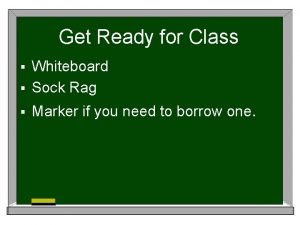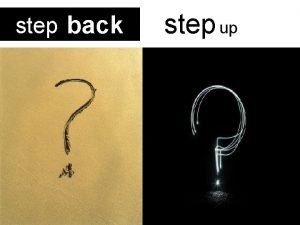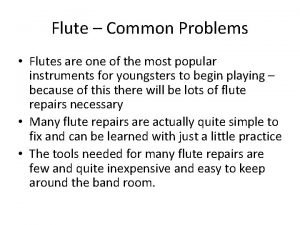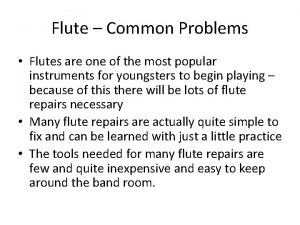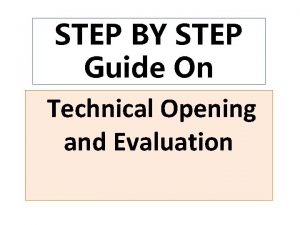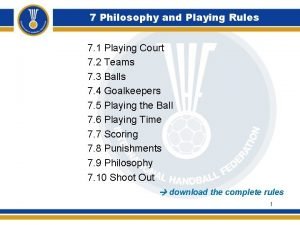Welcome to flute playing Step One Opening the


















- Slides: 18

Welcome to flute playing!

Step One: Opening the case Please do not open your flute on your lap! Find a table or rest your case on the floor! On most student flute cases, the logo is the top of the case, and the bottom of the case is slightly bigger than the bottom. Make sure the correct side is up because if it’s not, your flute will fall out of the case when you open it! If you are not playing your flute, leave it in the case. There are only three pieces- so when you’re used to assembling it, it’s not hard at all. Many broken flutes are caused by flutes being left on a bed, and then someone jumping onto the bed!

Step two: locate the parts There are three parts to a flute: headjoint, body and foot joint.

Step three: Headjoint Without touching the lip plate, take the headjoint out of the case. The first step to getting a sound on the flute completely relies on this, and the first few lessons will be how to make a sound on just this part. The shape of your mouth when you’re playing an instrument is called your “embouchure. ” The flute embouchure has been described as “despondent (wicked sad) fish!” Using a mirror can be very helpful in this step!

See if you can feel a bump at the top of your chin, where the bottom of your teeth are (but on the outside!). Mrs. La. Pierre calls this the flute shelf, because that is where your flute sits. The embouchure hole should be centered on your flute shelf. The sound in flute playing comes from air striking the further edge of the embouchure hole. Can you make a sad fish face with your flute on the flute shelf and make a noise just on the headjoint?

Sir James Galway will show you how it’s done! Aim your air towards your chin! Keep your corners down!

Don’t get discouraged! This is often the toughest part! Once you get a sound going, start using your tongue to start notes! It will mean that you have to use less air, and will sound better. You can actually play a few songs by putting your finger in the end of your headjoint, and changing how far in/out it is. Try Hot Cross Buns, Mary Had a Little Lamb or “Na. Na Batman!”

Assembling the rest of the flute Find the body of the flute, and take it out by the barrel, which is the part with the writing on it. Try to never grab the keys/rods of your flute- they are very delicate, and can bend easily, which might get your flute to stop working

Line the headjoint and the barrel of the body up, and gently twist into each other. Do not push the headjoint in all the way- leave about a nickel’s worth of that other metal exposed. Don’t worry, no one will see it when you are sitting on stage- but if you push your headjoint all the way in, it will play too high!

Line the embouchure hole up to the middle of the keys. Some flutes have arrows marked in, and we can add two little dots with Sharpie to make it easier. Sharpie comes off of metal with rubbing alcohol and does not damage the flute.

Now take the flute joint out by the end and twist it onto the other end of the body. Line the rod of the footjoint up to the center of the keys on the body. I know it looks like either the rods should line up, or the keys should line up, but that’s not how it works and your pinky will hurt if you try!

How to hold the flute Your left hand will be the busy hand at first. Your left palm will face your right shoulder. There is a key that sticks out- that is the G# key, and that is where your pinky goes. We won’t be pressing that key down for a while, but you can use that key to figure out where your other fingers go- your next two fingers go on the next two keys, then skip one, then your pointer finger. There also two keys for your thumb- try using the bigger thumb key.

The right hand is a bit easier to figure out! The first key on the footjoint is for your pinky- go ahead and put down your right pinky, and then the rest of your fingers should be over the keys that they need to be over. Put your thumb down where it’s comfortable for you, but where your fingers are slightly curved also.

Avoid having your left shoulder hold up your flute! It is okay (and encouraged) to twist your upper body to the left. Put your feet flat on the floor- even if it means your back isn’t resting on the chair. Your back probably shouldn’t rest on most chairs anyway!

Take apart your flute, and clean it! Twist off the footjoint and place it back in its spot in the case. Then separate the body and the headjoint and put them back in the case.

Take out the long cleaning rod that should have come with your flute- put a corner of your cleaning cloth into it, and fold the cloth over the top of the rod. Push the rod into the headjoint, twist to remove moisture, pull it out and put the headjoint back into the case. Push the cleaning rod through the flute starting at the barrel and pulling it out the other end. Repeat with the footjoint. Swab your flute out after you play- every time! Moisture=mold=yuck!

Dos and Don’ts… Don’t worry if you forget some of this information. Your teachers will be reviewing it, and reviewing it! Sometimes you lose it and find it again. . . Do ask your teacher for help if you need it- that’s what we are here to do! Don’t put your flute in the bathtub/dishwasher/pool to clean it- water is bad for your flute! Silver polish is also bad for your flute! All you need is your cleaning swab/rod! Do put that cleaning swab through the wash every so often… Do bring a broken flute to your teacher first. . . we are sometimes able to fix things (like broken springs) without a trip to the music store.

What to work on for your lesson: -Getting a sound out on just your headjoint. This is the most important thing you can do! -Putting your flute together. -Holding your flute.
 Step 1 step 2 step 3 step 4
Step 1 step 2 step 3 step 4 This organization put on a barbecue every summer
This organization put on a barbecue every summer Stage 1: denial
Stage 1: denial Opening prayer for praise and worship
Opening prayer for praise and worship Wise men three clever are we
Wise men three clever are we Incisor labiality
Incisor labiality Creating a dinosaur sculpture step by step
Creating a dinosaur sculpture step by step How to write an informative essay step by step
How to write an informative essay step by step Steps of argumentative essay
Steps of argumentative essay Step back step up
Step back step up Factor quadratic equations
Factor quadratic equations How to solve simultaneous equations
How to solve simultaneous equations Simultaneous equations step by step
Simultaneous equations step by step How to combine like terms step by step
How to combine like terms step by step Steps in photosynthesis
Steps in photosynthesis Matlab particle filter example
Matlab particle filter example Oracle real application testing
Oracle real application testing Veritas bare metal restore
Veritas bare metal restore Quadratic formula trigonometry
Quadratic formula trigonometry

